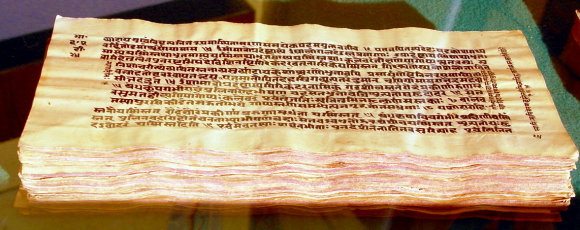VEDIC HERITAGE

Indian tradition has held the Vedas all along in highest reverence. It has given the Vedas the highest respect. In spite of all the centuries-old efforts of false debunking, the Vedas stand firm as a rock towering like snowy peaks of GouriShankar overtopping and overlooking the vast panoramic expanse below, drawing its nourishment every moment from the ceaseless streams that flow from above the huge and hoary expanse of Indian life and culture. We can find roots of almost all forms of Indian art and culture in this rich Vedic heritage.
Vedas are the only extant records of the lives and expressions of our forefathers of an age which is still unknown to the mankind. Vedas are regarded as the sacred revelations seen by Rishis in their deepest form of meditating. Vedas are the chants of these forefathers – Purve Pitarah - It is their hymns that form the starting point and the kernel of the vast literature that has flowed and developed from them and goes by the name VEDA. At some period of their history, very close to the epoch during which the hymns were first recited and celebrated, it was found necessary to collect and compile available hymns at that time. The necessity for the compilation may have arisen in order to prevent their loss inevitable with the passage of time and also to preserve them in their true form of chanting.
Tradition has it that they were compiled under the direction of Veda Vyasa – the author of Mahabharatha and one of the greatest intellectuals of ancient India. Certainly what have been compiled is not exhaustive of all the hymns that must have been ; the compilations represent the remnants that had survived the ravages of time and were still extant at the time of compilation. These hymnal texts were transcending down the generation mouth to mouth and it was inevitable that they must have suffered dilution in quantity with each generation.
The oral tradition of the Vedas (Šrauta) consists of several pathas, "recitations" or ways of chanting the Vedic mantras. Such traditions of Vedic chant are often considered the oldest unbroken oral tradition in existence, the fixation of the samhita texts as preserved dating to roughly the time of Homer (early Iron Age).
The various pathas are designed to allow the complete and perfect memorization of the text and its pronunciation, including the Vedic pitch accent – pada, krama, jata and Ghana.
Vedas are classified by Vyasa into Rigveda, Yajurveda, Samaveda and Atharvaveda. Each of these comprise of Mantra Samhita, the Brahmanas, the Aranyakas and the Upanishads.